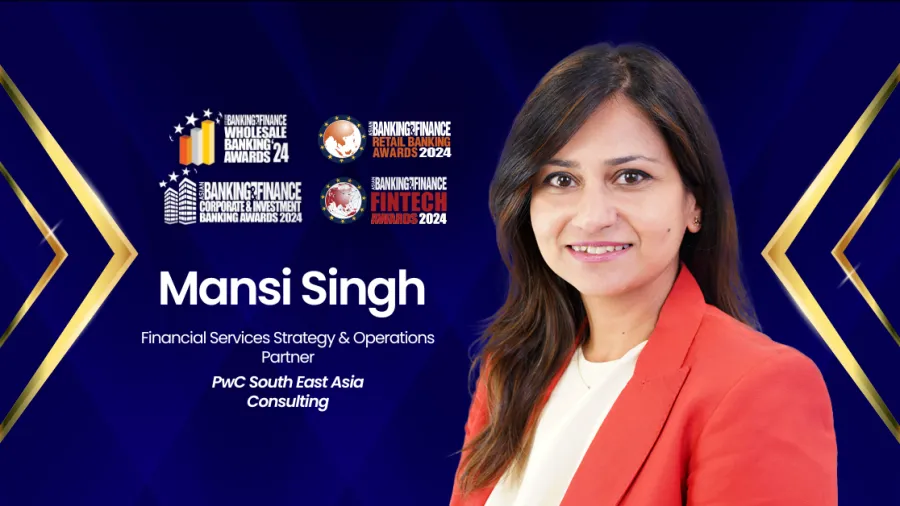
Financial services industry sees shift to digital, partnership-led business models, says PwC Partner
Industry innovations have become increasingly focussed towards customer centricity amidst keeping pace with evolving needs.
With 20 years of internal and external consulting experience under her belt, Mansi Singh is currently the Financial Services Strategy & Operations Partner at PwC South East Asia Consulting, and based in Singapore.
She works with financial institutions on strategy through execution across front-to-back enterprise-wide large-scale transformations, reimagining business and operating models, and driving organisational restructuring. Mansi has professional experience in Singapore, London, and the wider Asia Pacific, working with global, regional and local institutions.
Mansi shares her expertise in the banking & finance industry, having been amongst the esteemed judges at the Asian Banking & Finance Awards 2024. She provides insights on how technology continues to shape the financial services landscape, major shifts in the industry, effective risk management amidst innovating business models, and the integration of ESG considerations into business operations.
From your vantage point, what major shifts have you observed in the financial services industry across Southeast Asia in recent years and what factors are driving these changes?
Southeast Asia has seen a marked shift from traditional business models to more digital, innovative and partnership-led business models. A rapid increase in the number of digital banks and openness to partnerships is a sign of an innovative mindset. Financial institutions (FI) are increasingly focussed on customer-centricity and are transforming themselves not just to stay relevant today but also to keep pace with the fast-evolving customer needs and technological advancements.
More CEOs are leading with an entrepreneurial spirit, where business reinvention is top of mind. They are looking to balance the opportunities presented by emerging technologies and the flow of wealth to Southeast Asia with the need to manage macroeconomic trends—global geopolitical impacts, inflation, cost of business, and climate change—to name a few. Sustained profitable growth whilst derisking business is also one of the top priorities.
As technology continues to reshape the financial services landscape, how do you perceive the role of emerging technologies in driving innovation and efficiency within financial institutions?
We are seeing an unprecedented rate of technological advancement and democratisation in the last ten years, more so in recent years – this is akin to boarding a running train. GenAI is a truly transformative technology, with the potential to deliver 20% to 30% in value accretion across the banking value chain.
Distributed ledger technology and blockchain may have moved past the hype, with innovative use cases such as tokenisation services for cross-border payments, liquidity, carbon credits, and other financing solutions gaining pace. Ecosystem solutions, data, and cloud are at the centre of this accelerating change. Organisations that are late in embracing emerging technologies will struggle to generate value in the medium to long term.
Having said that, I am pleased to see very innovative submissions as part of the Asian Banking & Finance Awards, evidencing the fact that Southeast Asia has a thriving ecosystem with some of the most innovative homegrown solutions, with markings of becoming trailblazers.
How can financial institutions leverage technology and innovative business models to extend their services to underserved populations whilst managing risks effectively?
Emerging technologies are enabling institutions to reach underserved and unbanked populations. In the past, the biggest challenges have been around ascertaining the creditworthiness of individuals, as well as micro and small enterprises, and addressing overall financial literacy.
These technologies present an opportunity for FIs to build risk models with a diverse set of financial and ancillary data, opening up financing opportunities for the underserved. SMEs can also tap into the tools and technologies to make their enterprises more financially sound.
Furthermore, regulators are playing a pivotal role by tapping into the industry’s increasing intent to collaborate to create solutions that not only enable them to service the underserved but also ease the burden on organisations. Modular architecture and sophisticated data monetisation models—underpinning embedded finance—allow institutions to pilot and scale products and services much more rapidly.
For example, India has leapfrogged in the payments ecosystem and Indonesia is seeing a large number of upcoming digital banks. We are likely to see more of such instances in Southeast Asia.
Environmental, social, and governance (ESG) considerations are gaining prominence in the global business community. How do you see financial institutions in Southeast Asia integrating ESG principles into their strategies and decision-making processes?
ESG considerations and net-zero commitments are at the top of the agenda for financial institutions. In fact, they have a very important role to play, by looking inward at their own net-zero commitments as well as enabling businesses and society to become more ESG-conscious.
We are seeing an uptick in sustainable finance products, transition advisory, ESG-focussed funds, philanthropic investments, and an increased level of funding commitments towards the ESG agenda.
Moreover, with emerging ESG reporting requirements coming into play and greater transparency and commitment imposed by regulators, the next three to four years will be crucial. FIs are being asked to examine their impacts, both from upstream and downstream perspectives. Whilst there is a burden of compliance, there is also an opportunity to shape the future through active participation in policymaking.
Looking ahead, what do you believe will be the key priorities for financial institutions in Southeast Asia to remain competitive and sustainable amidst evolving market dynamics and regulatory requirements?
Attracting talent and upskilling people are one of the top priorities as FIs brace themselves for future growth. For sustained growth, FIs must differentiate themselves and improve the stickiness of customers.
Customers now demand fast, seamless, personalised, and intuitive experiences across both digital and in-person channels, with appropriate levels of security. Meeting these new customer expectations calls for new capabilities in areas like AI and machine learning and distributed-ledger technologies like blockchain—all of which are typically outside banks’ traditional areas of expertise.
In doing so, managing risks associated with data, cyber, fraud, and third parties will be imperative. FIs and policymakers will also need to work cohesively as they seek to balance the rapid pace of innovation, societal expectations, and competitiveness with financial stability.


















 Advertise
Advertise










